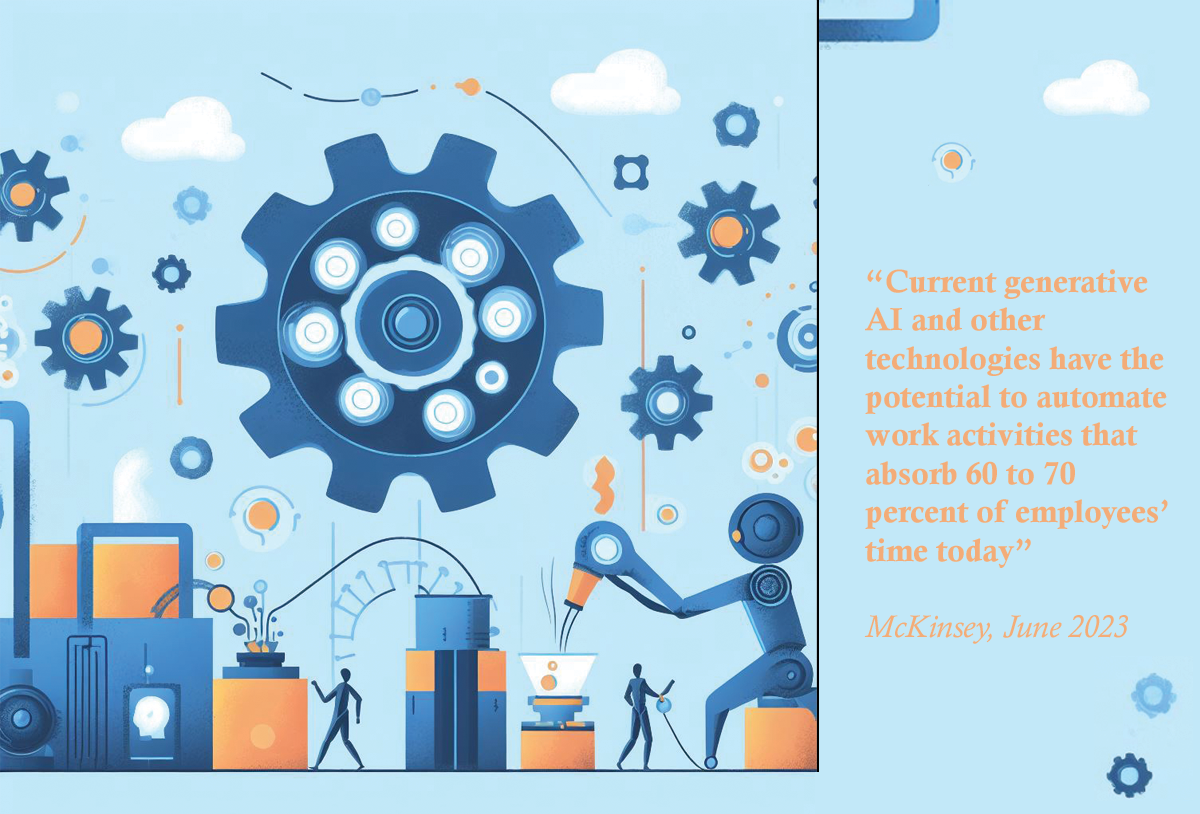
Is generative AI compatible with your business? This underlying question often resonates with business owners considering integrating AI into their operational processes. Below we delve deeper and share some thought-provoking ideas that might serve as a source of inspiration for our readers with concrete examples. These concepts, rooted in both past lessons and future possibilities, aim to stimulate discussions and foster innovative thinking.
From semantic searches to content creation, the innovative applications of generative AI are reshaping industries, providing solutions to age-old problems, reducing development time and costs, and offering unparalleled efficiencies. Here, we delve into some intriguing use cases that highlight its transformative power and potential for faster, more cost-effective operational processes.
Generative AI is not just a buzzword; it’s a revolution in technology that’s already making waves across industries. But what is it actually? Generative AI is a branch of artificial intelligence that enables machines to produce new content, spanning text, code, voice, images, videos, and processes. It recently reached a level of understanding and general knowledge that was previously unthinkable thanks to companies such as Open AI, Google or Facebook.
As AI continues to evolve, the potential applications and benefits will only grow, making it an indispensable tool for businesses. Generative AI offers a plethora of advantages for businesses across various sectors. From understanding user intent, providing personalized customer experience at scale or easily automating repetitive tasks, gen AI is already helping many companies and businesses to gain efficiency and speed while lowering cost.
Leveraging genAI understanding for improved information processing and retrieval
GenAI leverages deep learning to understand the underlying meaning and context of user queries, rather than relying on classic keyword matches. This approach enables more relevant and nuanced search results by capturing the intent behind the user’s input.
Watchmaking Industry
In the watchmaking industry researchers and engineers often need inspiration and technical documentation on past models to inform their designs, maintain historical accuracy, and innovate while preserving tradition. However, it might be complex with keyword retrieval systems to find accurate matches, missing out on a wealth of relevant content that might be described or cataloged differently. The intricate details and nuances of watchmaking can be challenging to encapsulate with just a few keywords, leading to incomplete or non-representative search results, hindering their research process.

For example, a researcher looking to know about the most complex mechanism for a watch will find a plethora of results with a keyword search with most documents talking about how complex are watches without giving a clear answer to the search. While a genAI search will understand the underlying meaning of the search and will answer directly that minute repeater or grand bell are considered some of the most complex mechanisms, while providing the researcher with sources from which the information was discovered, either from a pdf document or from the middle of a video. This approach provides a more tailored response, enriching user experiences. The watchmaking industry has tons of documentation and content, it’s crucial to go beyond mere keyword retrieval to effectively facilitate user discovery of content.
Lawyers: Jurisprudence and Legal Documents
Lawyers face the intricate challenge of navigating through vast repositories of jurisprudence and legal documents to find pertinent information that is crucial for case preparation and legal decision-making. Experienced lawyers often find it somewhat easier to locate relevant cases and legal documents due to their familiarity with legal terminologies and their knowledge of specific, precedent-setting cases. However, for newer practitioners, navigating through the expansive and intricate repositories of legal documents can present a considerable challenge. The conventional keyword-based search strategies tend to be less efficient, as they may not fully comprehend the nuanced contexts and specialized legal terminologies, potentially leading to overlooked critical information.

A solution is sought in generative AI and semantic search, which can illuminate the path for both experienced and novice lawyers alike by providing an intelligent, context-aware information retrieval system. This technological approach promises to understand and interpret the varied contexts and specificities in legal documentation, ensuring all practitioners can access crucial, relevant information, regardless of their level of experience.
For instance, if a variation in a contract stems from a change in the law and the adaptation of the contract is correct and therefore necessary, the system could automatically suggest all the other contracts that have already been drawn up so that former customers can be easily contacted to ensure compliance of their activities. As we can see, AI can easily bring in additional business for law firms while ensuring a quality service for long-standing clients.
Content Creation
Content Creation with genAI utilizes deep learning to generate contextually relevant and coherent content based on given prompts or data. This allows for the production of diverse and tailored materials, from written articles to designs, with a deeper understanding of context and nuance.
RFP management and answers generation
Traditional Request for Proposals (RFP) management systems often grapple with issues like difficulty in locating specific questions, maintaining a well-organized database of questions, and the manual, time-consuming effort required to craft articulate responses. The classic systems generally rely on static databases where finding pertinent questions often becomes a laborious, keyword-based search task. Maintaining and updating this database to remain coherent and relevant with the evolving needs and standards of various industries further exacerbates the challenge. Moreover, even with a robust database, professionals still need to manually compose their responses, a process that demands time, expertise, and consistency in maintaining the quality and relevance of the answers.
Gen AI emerges as a viable solution to these pain points by offering dynamic, intelligent, and automated assistance throughout the RFP management process. It enables semantic search capabilities, ensuring that users can find relevant questions by understanding the intent behind their search, rather than relying on exact keyword matches. Additionally, it can assist in automatically crafting well-structured, informative, and contextually relevant responses, thereby significantly reducing the manual effort and enhancing the efficiency and accuracy of the RFP process. Moreover, with continuous learning capabilities, it can help in keeping the database of questions up-to-date and refined based on ongoing usage and feedback, ensuring that the system evolves and stays aligned with user needs and industry trends.
Conclusion
Through these examples we hope you got insights on what you could do with your data and processes thanks to gen AI. At Yumytech, we’ve been closely following developments in this field for many years, and we’re in a position to help companies like yours to become more responsive to their customers, optimize their day-to-day tasks or reduce their costs. Would you like to investigate the potential in your company? Send us a message to get started on your innovation journey.
Your contact regarding genAI

Charles Malafosse, CTO at Yumytech


Recent Comments